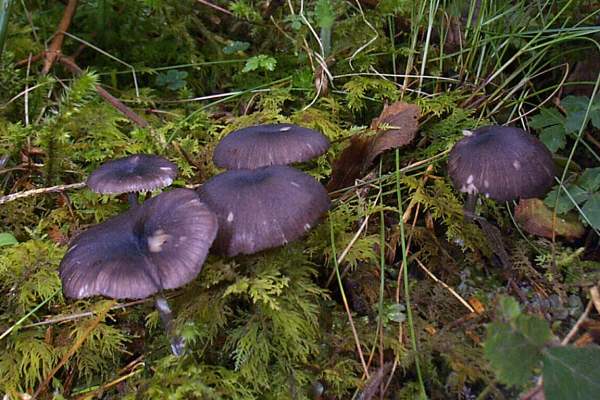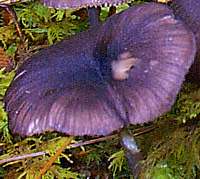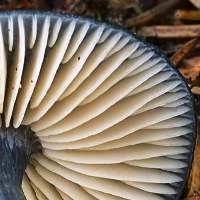Trees Birds Mammals Fish Amphibians Reptiles
Wild Algarve
Bookshop
Entoloma nitidum Quél. - Pine Pinkgill
Phylum: Basidiomycota - Class: Agaricomycetes - Order: Agaricales - Family: Entolomataceae
Distribution - Taxonomic History - Etymology - Identification - Culinary Notes - Reference Sources

Blue species of Entoloma are very difficult to identify with certainty from macroscopic characters alone; however, this indigo-coloured woodland mushroom is an exception; the trick is to note the habitat. Entoloma nitidum grows in wet, mossy conifer forests on acidic soil, whereas other blue species grow in grassland or in light woodland on chalky soil.
Strikingly beautiful when seen against a bright green mossy background, Entoloma nitidum occurs singly or in small groups.
Distribution
The lovely Pine Pinkgill mushroom is uncommon to rare in Britain and Ireland, and although widespread across mainland North-west Europe it tends to be localised. Entoloma nitidum is also found in parts of North America.
Taxonomic history
This uncommon mushroom was described scientifically in 1887 by the Italian mycologist Giacopo Bresadola (1847 - 1929), who gave it the name Nolanea papillata. It was the British mycologist Richard William George Dennis (1910 - 2003) who, in 1953, transferred this species to its current genus, at which point its binomial scientific name became Entoloma papillatum.
Synonyms of Entoloma papillatum include Nolonea papillata Bres., Nolanea mammosa ssp. papillata (Bres.) Konrad & Maubl., and Rhodophyllus papillatus (Bres.) J. E. Lange.
Etymology
The generic name Entoloma comes from ancient Greek words entos, meaning inner, and lóma, meaning a fringe or a hem. It is a reference to the inrolled margins of many of the mushrooms in this genus.
The specific epithet nitidum means shining, polished or glittering; quite appropriate!
Identification guide
 |
Cap
2 to 4 cm across, convex, flattening and sometimes becoming broadly umbonate; silky fibrillose surface; margin striate, slightly incurved and often becoming wavy; dark blue or greyish-blue, paler towards the rim.
|
 |
Gills
Adnate; white, turning pink as the spores mature. (Picture Andreas Kunze, Wikipedia)
Stem
3 to 6 cm long and 1 to 2mm diameter; smooth; greyish-blue; white and felty at base; longitudinally fibrillose; no stem ring. |
| |
Spores
Five- to eight-angled (pentagonal to octagonal) in side view;thin-walled; 7-9 x 6-8μm.
Spore print
Brownish pink. |
Odour/taste |
Mild but not distinctive. |
Habitat & Ecological role |
Saprobic in coniferous woodland, especially with pine trees, usually on acidic soil. |
Season |
Fruiting from summer to late autumn in Britain and Ireland. |
Similar species |
Entoloma serrulatum has finely serrated giil edges flecked with black. |
Culinary Notes
Entoloma nitidum is too rare to be collected for the pot, and it is generally considered inedible. (This mushroom is also thin-fleshed and insubstantial.)
Reference Sources
Fascinated by Fungi, 2nd Edition, Pat O'Reilly 2016, reprinted by Coch-y-bonddu Books in 2022.
Studies in the genus Entoloma (Basidiomycota, Agaricales) from the Kiklades (C. Aegean, Greece), Machiel Noordeloos & Elias Polemis; Mycotaxon, Volume 105, pp. 301–312 July–September 2008.
Knudsen H., Vesterholt J. (eds) Funga Nordica: agaricoid, boletoid and cyphelloid genera - Nordsvamp, 2008
BMS List of English Names for Fungi
Dictionary of the Fungi; Paul M. Kirk, Paul F. Cannon, David W. Minter and J. A. Stalpers; CABI, 2008
Taxonomic history and synonym information on these pages is drawn from many sources but in particular from the British Mycological Society's GB Checklist of Fungi.
Top of page...
Fascinated by Fungi. Back by popular demand, Pat O'Reilly's best-selling 450-page hardback book is available now. The latest second edition was republished with a sparkling new cover design in September 2022 by Coch-y-Bonddu Books. Full details and copies are available from the publisher's online bookshop...